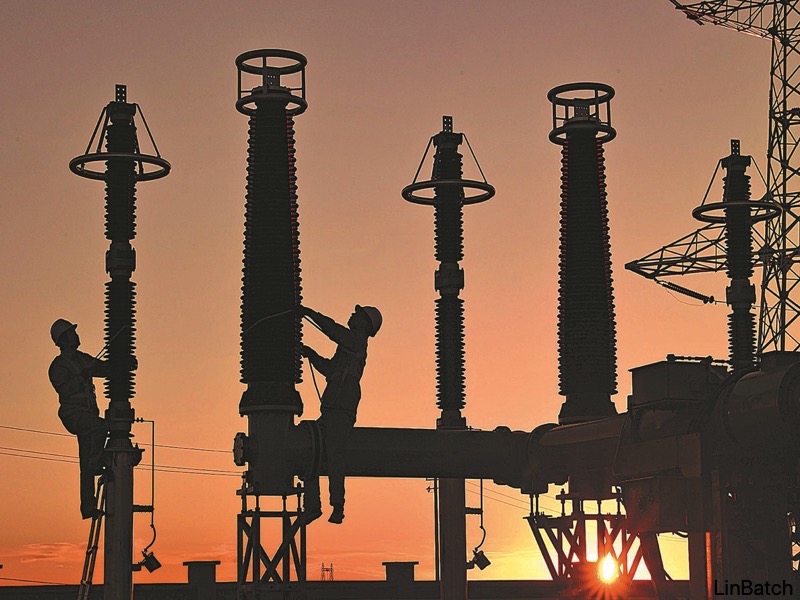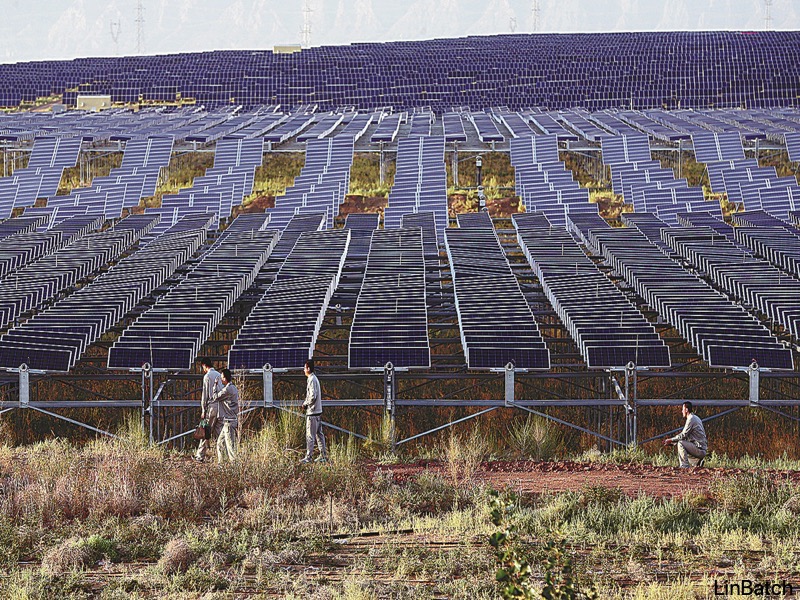Inner Mongolia's sun to help power nation
Editor's note: China has seen tremendous changes nationwide, from economic growth to environmental protection, from social improvement to cultural progress. In this series, China Daily maps the changes and tells the stories of the people who lived through them.

Workers install equipment at a solar power generation project in Ejin Horoo Banner, Ordos, Inner Mongolia autonomous region, last year. [Photo by Wang Zheng/For CHINA DAILY]
Massive new solar, wind projects weaning region off fossil fuels, helping charge national grid.
Mechanical arms remove empty 2.5-metric-ton cells from a heavy-duty electric truck and replace them with fully charged ones. The entire process takes just five minutes.
The charging station in Ordos, Inner Mongolia autonomous region, is fully automated. All drivers need to do is scan a code to use it. The station, which went into operation last month, can service 150 heavy-duty electric trucks a day.
In the Hohhot-Baotou-Ordos cluster, a major coal-producing area, thousands of trucks transport the fuel each day. They not only run on fossil energy, but also are major contributors of air pollution. However, the adoption of the intelligent charging station is expected to help change that situation soon.
As China forges toward meeting its climate targets of reaching peak carbon emissions before 2030 and carbon neutrality before 2060, the station is just one example of the ongoing green transition in the region.

Technicians go on an inspection tour at a solar power farm in the Kubuqi Desert, Inner Mongolia. [Photo by Zou Hong/CHINA DAILY]
Spurred by the concerns of President Xi Jinping, the region's transition has gained momentum in recent years, with a series of ambitious plans to make it a major supplier of renewable energy.
While participating in deliberations with the region's delegation to the Fifth Session of the 13th National People's Congress in March, Xi said that he hoped that people in Inner Mongolia would follow a path of high-quality development that prioritizes environmental protection and green development, and stressed the importance of the full and faithful implementation of the new development philosophy.
Xi called for efforts to turn Inner Mongolia into a national center for key energy and strategic resources and said that efforts should be made to hasten the green transformation of key industries and areas, foster cleaner production and accelerate green and low-carbon development.
The automated charging station in Ordos is just one of 20 that the Ordos Lyudong Coal Transportation and Marketing Company plans to build this year in the cluster, according to Zhang Feng, the company's president. It also plans a fleet of 1,000 heavy-duty electric trucks.
During the 14th Five-Year Plan (2021-25) period, Ordos Lyudong will extend its intelligent station network to Wuhai, another major coal-producing area in Inner Mongolia, Zhang said, with a further 120 stations to be built and an additional 10,000 heavy-duty electric trucks put into service.
"For every 10,000 heavy-duty electric trucks, carbon dioxide emissions can be reduced by over 1 million tons if each runs for 100,000 km a year," said Xin Ran, the company's vice-general manager. "They will also help reduce the emissions of particulates and carbon monoxide."

Water birds roost in the Juyanhai wetland in Alshaa League, Inner Mongolia. [Photo/CHINA DAILY]
The introduction of heavy-duty electric trucks is just one of a series of measures the region is carrying out to increase its capacity to make use of renewable energy.
Last year, Inner Mongolia sent 246.7 billion kilowatt-hours of electricity to other regions, 15 percent of total cross-regional transmission that year. According to regional authorities, Inner Mongolia has been working to transform its industrial structure and mix of energy since the 18th CPC National Congress in 2012.
Currently, new energy accounts for just over 20 percent of energy consumption in the region, but there are plans for the installed capacity for new energy, which now accounts for one-third of the region's total installed capacity, to outpace coal-fired power by 2025.
By 2030, renewable power should become the dominant source of energy, replacing coal-fired generation altogether.
Eight national wind and solar energy centers have been greenlighted in the region, and five more major centers are in the final stages of examination and approval. Together, they represent an installed capacity of about 32.1 million kilowatts.
In the Kubuqi Desert, for example, workers are busy setting up frames to accommodate solar energy modules as they forge ahead with the construction of the largest center in the country combining solar energy generation and desertification control.
Capable of reducing wind speeds by 1.5 meters per second, the project will also help lower the evaporation rate, and so apart from generating 4 billion kilowatt-hours of green electricity a year, it will help turn the desert into cultivated land, said Qu Yuwen, who heads the project.
"The region will prioritize developing wind and solar energy centers in deserts and wasteland," said Chen Zheng, deputy head of the Inner Mongolia Energy Administration. "It will coordinate efforts to enhance its ability to guarantee national energy security and promote a green, low-carbon transition."



 Print
Print Mail
Mail


